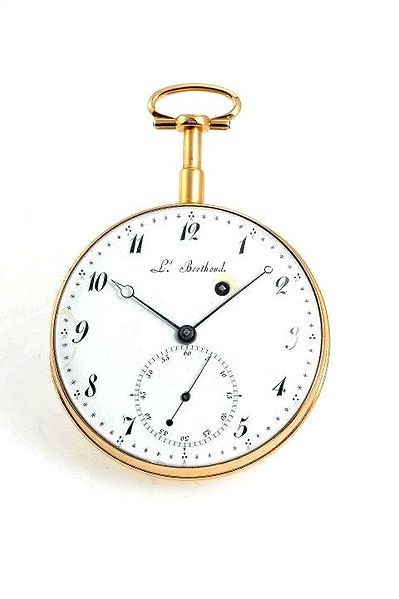Datei:Louis Berthoud à Paris, Werk Nr. 2521 (1).jpg

Originaldatei (480 × 721 Pixel, Dateigröße: 26 KB, MIME-Typ: image/jpeg)
Louis Berthoud à Paris, Werk Nr. 2521, 53 mm, 122 gr., circa 1793
Bedeutender Taschenchronometer mit Viertelstundenrepetition "montre à toc" - verkauft am 20. März 1793 an M. Blanchard de Pigou für den Preis von 70 Louis d'or - es handelt sich hier um eine der ersten französischen Uhren mit Rubinlagersteinen. Geh.: 18Kt Roségold, glatt, Gehäusemacher-Punzzeichen für "Joly". Ziffbl.: Email, arab. Zahlen, kleine Sekunde, offene Breguet Zeiger. Werk: Vollplatinenwerk, gekörnt, vergoldet, signiert, 2 Hämmer, Kette/Schnecke, massive Werkspfeiler, Federchronometerhemmung nach Thomas Earnshaw, dreiarmige Messingunruh, gebläute Unruhspirale.
Als Louis Berthoud 1784 die Leitung der Werkstatt seines Onkels Ferdinand nach dem Selbstmord von Henry Berthoud im Jahr zuvor übernahm bestand er darauf, dass die Geschäftsbücher so sorgfältig wie möglich geführt wurden. Die Bücher sind im Conservatoire National des Arts et Métiers in Paris erhalten und die vorliegende Uhr ist dort aufgeführt als "Montre à Répètition, à secondes excentriques, èchappement libre par Monsieur moret. Le 20 mars 1793 vendue à Monsiieur Blanchard de Pigon pour le prix de 70 Louis recus comptant" (Uhr mit Schlagwerk und abgesetzter Sekundenanzeige, freie Hemmung von Monsieur Moret. Verkauft an Monsieur Blanchard de Pigon am 20. März 1793 für die Summe von siebzig Talern, Betrag erhalten).
Es handelt sich hierbei zweifellos um eine der ersten Uhren mit Lagersteinen in Frankreich. Dieses Herstellungsgeheimnis wurde in England streng gehütet seit Nicholas de Facio es um 1704 dorthin mitgebracht hatte. Louis Berthoud erkannte den großen Vorteil, den die Engländer durch den Einsatz der Steine hatten und es gelang ihm schließlich, das Geheimnis zu lüften wie die Steine zu bohren und zu polieren waren; danach stellte er Arbeiter ein, die diese Fertigkeit erlernten. Die ursprüngliche klassische Louis Berthoud Wippenchronometerhemmung wurde um die Mitte des 19. Jahrhunderts durch eine Federhemmung ersetzt, das Originalrad wurde jedoch aufbewahrt.
Quelle: "The Catalogue of Chronometers in the Time Museum", Anthony Randall, Rockford, Illinois 1992, S. 86f
Beschrieben in Jean-Claude Sabrier, "Longitude at Sea in the time of Louis Berthoud", Genf 1993, S. 397 und Anthony Randall "The Catalogue of Chronometers in the Time Museum", Rockford, Illinois 1992, S. 86f.
An important quarter repeating pocket chronometer "montre à toc" - sold to Monsieur Blanchard de Pigon on the March 20th, 1793 for the sum of 70 Louis d'Or - one of the earliest watches in France to be fitted with pierced jewels. Case: 18k rose gold, smooth, case maker punch mark of "Joly". Dial: enamel, Arabic numerals, auxiliary seconds, opened Breguet hands. Movm.: full plate movement, frosted, gilt, signed, 2 hammers, chain/fusee, solid movement pillars, spring detent escapement according to Thomas Earnshaw, three-arm brass balance, blued balance spring.
When Louis Berthoud took over the management of his uncle Ferdinand's workshop in Paris in 1784, following the suicide of Henry Berthoud in 1783, Ferdinand insisted that accurate accounts should be kept on the firm's activities. These are preserved in the Conservatoire National des Arts et Métiers in Paris. According to the books, this watch is recorded as "Montre à Répètition, à secondes excentriques, èchappement libre par Monsieur moret. Le 20 mars 1793 vendue à Monsiieur Blanchard de Pigon pour le prix de 70 Louis recus comptant" (repeating watch with offset seconds indication, detached escapament by Monsieur Moret. Sold to Monsieur Blanchard de Pigon on the March 20th, 1793 for the sum of secventy Louis, received).
It must be one of the earliest watches in France to be fitted with pierced jewels. The secret had been kept in England since it was brought there from the Cpntinent in about 1704 by Nicholas de Facio. Louis Berthoud, realising the great advantage obtained by the British in the use of jewels, was finally able to discover the secret of drilling and polishing them and to obtain workers who could practice the skill. Originally made with the typical Louis Berthoud pivoted detent escapement, the escapement was replaced by a spring detent escapement towards the middle of the 19th century, but the original escape wheel was preserved.
Source: "The Catalogue of Chronometers in the Time Museum",Anthony Randall, Rockford, Illinois 1992, S. 86f.
Described in "Longitude at Sea in the time of Louis Berthoud" by Jean-Claude Sabrier, Geneva 1993, p. 397 and "The Catalogue of Chronometers in the Time Museum" by Anthony Randall, Rockford, Illinois 1992, p. 86f.

|
Alle Bildrechte liegen bei dem Auktionshaus Auktionen Dr. H. Crott. Diese Abbildung ist urheberrechtlich geschützt und steht nicht unter einer freien Lizenz. Für anderweitige Nutzungen außerhalb von Watch-Wiki ist die schriftliche Zustimmung des Urheberrechtsinhabers nötig. |
Dateiversionen
Klicke auf einen Zeitpunkt, um diese Version zu laden.
| Version vom | Vorschaubild | Maße | Benutzer | Kommentar | |
|---|---|---|---|---|---|
| aktuell | 20:53, 22. Okt. 2011 |  | 480 × 721 (26 KB) | Andriessen (Diskussion | Beiträge) | Louis Berthoud à Paris, Werk Nr. 2521, 53 mm, 122 gr., circa 1793 Bedeutender Taschenchronometer mit Viertelstundenrepetition "montre à toc" - verkauft am 20. März 1793 an M. Blanchard de Pigou für den Preis von 70 Louis d'or - es handelt sich hier |
Du kannst diese Datei nicht überschreiben.
Dateiverwendung
Die folgende Seite verwendet diese Datei:
- Bildgalerie Uhrenmodelle Berthoud, Pierre Louis
- Picture gallery watch models Berthoud, Pierre Louis
- Galería de imagenes de modelos de relojes Berthoud, Pierre Louis
- Afbeeldingen galerij uurwerkmodellen Berthoud, Pierre Louis
- Фотогалерея Модели часов Berthoud, Pierre Louis
- Galleria fotografica di modelli orologi Berthoud, Pierre Louis